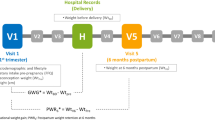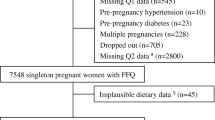Abstract
Preeclampsia and preterm delivery are serious complications of pregnancy and leading causes of perinatal mortality and morbidity worldwide. Dietary factors might be associated with these adverse outcomes. We investigated whether adherence to the New Nordic Diet (NND) was associated with preeclampsia and preterm delivery risks in the Norwegian Mother and Child Cohort Study (MoBa). Participants were recruited from all over Norway during the period 1999–2008. A previously constructed diet score assessing meal frequency, and the consumption of Nordic fruits, root vegetables, cabbages, potatoes, oatmeal porridge, whole grains, wild fish, game, berries, milk and water, was used to assess NND adherence. Associations between NND adherence and the outcomes were estimated in adjusted multivariate logistic regression models. Odds ratios (ORs) and 95 % confidence intervals (CIs) were calculated. A total of 72,072 women was included in the study. High versus low NND adherence was associated with lower risk of total preeclampsia (OR 0.86; 95 % CI 0.78–0.95) and early preeclampsia (OR 0.71; 95 % CI 0.52–0.96). High compared with low NND adherence was associated with a lower risk of spontaneous preterm delivery among nulliparous women (OR 0.77; 95 % CI 0.66–0.89), whereas multiparous women with high NND adherence had a marginally significant higher risk of preterm delivery (OR 1.24; 95 % CI 1.00–1.53). High NND adherence was associated with a lower relative risk of preeclampsia and of spontaneous preterm delivery among nulliparous women; however, among multiparous women there was a higher relative risk of preterm delivery.
Similar content being viewed by others
References
Sibai B, Dekker G, Kupferminc M. Pre-eclampsia. Lancet. 2005;365(9461):785–99.
Klungsøyr K, Morken NH, Irgens L, Vollset SE, Skjærven R. Secular trends in the epidemiology of pre-eclampsia throughout 40 years in Norway: prevalence, risk factors and perinatal survival. Paediatr Perinat Epidemiol. 2012;26(3):190–8. doi:10.1111/j.1365-3016.2012.01260.x.
Redman CWG, Sargent IL. Immunology of pre-eclampsia. Am J Reprod Immunol (New York, NY: 1989). 2010;63(6):534–43. doi:10.1111/j.1600-0897.2010.00831.x.
Brennan LJ, Morton JS, Davidge ST. Vascular dysfunction in preeclampsia. Microcirculation (New York, NY: 1994). 2014;21(1):4–14. doi:10.1111/micc.12079.
Ghio A, Bertolotto A, Resi V, Volpe L, Di Cianni G. Triglyceride metabolism in pregnancy. Adv Clin Chem. 2011;55:133–53.
Morken N-H, Källen K, Jacobsson B. Outcomes of preterm children according to type of delivery onset: a nationwide population-based study. Paediatr Perinat Epidemiol. 2007;21(5):458–64.
Rogers LK, Velten M. Maternal inflammation, growth retardation, and preterm birth: insights into adult cardiovascular disease. Life Sci. 2011;89(13–14):417–21. doi:10.1016/j.lfs.2011.07.017.
Xu H, Shatenstein B, Luo Z-C, Wei S, Fraser W. Role of nutrition in the risk of preeclampsia. Nutr Rev. 2009;67(11):639–57. doi:10.1111/j.1753-4887.2009.00249.x.
Martinez-Gonzalez MA, Bes-Rastrollo M, Serra-Majem L, Lairon D, Estruch R, Trichopoulou A. Mediterranean food pattern and the primary prevention of chronic disease: recent developments. Nutr Rev. 2009;67(Suppl 1):S111–6.
Bere E, Brug J. Towards health-promoting and environmentally friendly regional diets—a Nordic example. Public Health Nutr. 2009;12(1):91–6. doi:10.1017/s1368980008001985.
Mithril C, Dragsted LO, Meyer C, Blauert E, Holt MK, Astrup A. Guidelines for the New Nordic Diet. Public Health Nutr. 2012;15(10):1941–7. doi:10.1017/s136898001100351x.
Kanerva N, Kaartinen NE, Ovaskainen M-L, Konttinen H, Kontto J, Männistö S. A diet following Finnish nutrition recommendations does not contribute to the current epidemic of obesity. Public Health Nutr. 2012;1–9.
Kanerva N, Kaartinen NE, Schwab U, Lahti-Koski M, Männistö S. Adherence to the Baltic Sea diet consumed in the Nordic countries is associated with lower abdominal obesity. Br J Nutr. 2012;1–9.
Uusitupa M, Hermansen K, Savolainen MJ, Schwab U, Kolehmainen M, Brader L et al. Effects of an isocaloric healthy Nordic diet on insulin sensitivity, lipid profile and inflammation markers in metabolic syndrome—A randomized study (SYSDIET). J Intern Med. 2013.
Kyrø C, Skeie G, Loft S, Overvad K, Christensen J, Tjønneland A et al. Adherence to a healthy Nordic food index is associated with a lower incidence of colorectal cancer in women: the Diet, Cancer and Health cohort study. Br J Nutr. 2012:1–8.
Olsen A, Egeberg R, Halkjær J, Christensen J, Overvad K, Tjønneland A. Healthy aspects of the Nordic diet are related to lower total mortality. J Nutr. 2011;141(4):639–44. doi:10.3945/jn.110.131375.
Adamsson V, Reumark A, Fredriksson IB, Hammarstrom E, Vessby B, Johansson G. Effects of a healthy Nordic diet on cardiovascular risk factors in hypercholesterolaemic subjects: a randomized controlled trial (NORDIET). J Intern Med. 2011;269:150–9.
Uusitupa M, Hermansen K, Savolainen MJ, Schwab U, Kolehmainen M, Brader L. Effects of an isocaloric healthy Nordic diet on insulin sensitivity, lipid profile and inflammation markers in metabolic syndrome - a randomized study (SYSDIET). J Intern Med. 2013;274:52–66.
Poulsen SK, Due A, Jordy AB, Kiens B, Stark KD, Stender S et al. Health effect of the New Nordic Diet in adults with increased waist circumference: a 6-mo randomized controlled trial. Am J Clin Nutr. 2013.
Brader L, Uusitupa M, Dragsted LO, Hermansen K. Effects of an isocaloric healthy Nordic diet on ambulatory blood pressure in metabolic syndrome: a randomized SYSDIET sub-study. Eur J Clin Nutr. 2013.
Goldenberg RL, Culhane JF, Iams JD, Romero R. Epidemiology and causes of preterm birth. The lancet. 2008;371(9606):75–84.
Mudd LM, Holzman CB, Catov JM, Senagore PK, Evans RW. Maternal lipids at mid-pregnancy and the risk of preterm delivery. Acta Obstet Gynecol Scand. 2012;91(6):726–35. doi:10.1111/j.1600-0412.2012.01391.x.
Hillesund ER, Bere E, Haugen M, Overby NC. Development of a New Nordic Diet score and its association with gestational weight gain and fetal growth—a study performed in the Norwegian Mother and Child Cohort Study (MoBa). Public Health Nutr. 2014:1–11.
Magnus P, Irgens LM, Haug K, Nystad W, Skjaerven R, Stoltenberg C. Cohort profile: the Norwegian Mother and Child Cohort Study (MoBa). Int J Epidemiol. 2006;35(5):1146–50.
Brantsæter AL, Haugen M, Alexander J, Meltzer HM. Validity of a new food frequency questionnaire for pregnant women in the Norwegian Mother and Child Cohort Study (MoBa). Matern Child Nutr. 2008;4(1):28–43. doi:10.1111/j.1740-8709.2007.00103.x.
Meltzer HM, Brantsaeter AL, Ydersbond TA, Alexander J, Haugen M. Methodological challenges when monitoring the diet of pregnant women in a large study: experiences from the Norwegian Mother and Child Cohort Study (MoBa). Matern Child Nutr. 2008;4(1):14–27. doi:10.1111/j.1740-8709.2007.00104.x.
Bach A, Serra-Majem L, Carrasco JL, Roman B, Ngo J, Bertomeu I, et al. The use of indexes evaluating the adherence to the Mediterranean diet in epidemiological studies: a review. Public Health Nutr. 2006;9(1A):132–46.
Skjaerven R, Gjessing HK, Bakketeig LS. Birthweight by gestational age in Norway. Acta Obstet Gynecol Scand. 2000;79(6):440–9.
Barker DJP, Lampl M, Roseboom T, Winder N. Resource allocation in utero and health in later life. Placenta. 2012;33(Suppl 2):e30–4. doi:10.1016/j.placenta.2012.06.009.
Thangaratinam S, Rogozinska E, Jolly K, Glinkowski S, Roseboom T, Tomlinson JW, et al. Effects of interventions in pregnancy on maternal weight and obstetric outcomes: meta-analysis of randomised evidence. BMJ Clin Res Ed. 2012;344:e2088. doi:10.1136/bmj.e2088.
Brantsaeter AL, Haugen M, Samuelsen SO, Torjusen H, Trogstad L, Alexander J, et al. A dietary pattern characterized by high intake of vegetables, fruits, and vegetable oils is associated with reduced risk of preeclampsia in nulliparous pregnant Norwegian women. J Nutr. 2009;139(6):1162–8. doi:10.3945/jn.109.104968.
Qiu C, Coughlin KB, Frederick IO, Sorensen TK, Williams MA. Dietary fiber intake in early pregnancy and risk of subsequent preeclampsia. Am J Hypertens. 2008;21(8):903–9. doi:10.1038/ajh.2008.209.
Ozkan H, Cetinkaya M, Koksal N. Increased incidence of bronchopulmonary dysplasia in preterm infants exposed to preeclampsia. J Matern Fetal Neonatal Med. 2012;25(12):2681–5. doi:10.3109/14767058.2012.708371.
Savitz DA, Harmon Q, Siega-Riz AM, Herring AH, Dole N, Thorp JM Jr. Behavioral influences on preterm birth: integrated analysis of the pregnancy, infection, and nutrition study. Matern Child Health J. 2012;16(6):1151–63. doi:10.1007/s10995-011-0895-5.
Khoury J, Henriksen T, Christophersen B, Tonstad S. Effect of a cholesterol-lowering diet on maternal, cord, and neonatal lipids, and pregnancy outcome: a randomized clinical trial. Am J Obstet Gynecol. 2005;193(4):1292–301.
Haugen M, Meltzer HM, Brantsaeter AL, Mikkelsen T, Osterdal ML, Alexander J, et al. Mediterranean-type diet and risk of preterm birth among women in the Norwegian Mother and Child Cohort Study (MoBa): a prospective cohort study. Acta Obstet Gynecol Scand. 2008;87(3):319–24.
Mikkelsen TB, Osterdal ML, Knudsen VK, Haugen M, Meltzer HM, Bakketeig L, et al. Association between a Mediterranean-type diet and risk of preterm birth among Danish women: a prospective cohort study. Acta Obstet Gynecol Scand. 2008;87(3):325–30. doi:10.1080/00016340801899347.
Englund-Ögge L, Brantsæter AL, Sengpiel V, Haugen M, Birgisdottir BE, Myhre R, et al. Maternal dietary patterns and preterm delivery: results from large prospective cohort study. BMJ (Clinical Research Ed). 2014;348:g1446. doi:10.1136/bmj.g1446.
Laughon SK, Albert PS, Leishear K, Mendola P. The NICHD Consecutive Pregnancies Study: recurrent preterm delivery by subtype. Am J Obstet Gynecol. 2014;210(2):131.e1–8. doi:10.1016/j.ajog.2013.09.014.
Moeller SM, Reedy J, Millen AE, Dixon LB, Newby PK, Tucker KL, et al. Dietary patterns: challenges and opportunities in dietary patterns research an Experimental Biology workshop, April 1, 2006. J Am Diet Assoc. 2007;107(7):1233–9.
Hu FB. The Mediterranean diet and mortality–olive oil and beyond. N Engl J Med. 2003;348(26):2595–6.
Thomsen LCV, Klungsøyr K, Roten LT, Tappert C, Araya E, Baerheim G, et al. Validity of the diagnosis of pre-eclampsia in the Medical Birth Registry of Norway. Acta Obstet Gynecol Scand. 2013;92(8):943–50. doi:10.1111/aogs.12159.
Olafsdottir AS, Thorsdottir I, Gunnarsdottir I, Thorgeirsdottir H, Steingrimsdottir L. Comparison of women’s diet assessed by FFQs and 24-hour recalls with and without underreporters: associations with biomarkers. Ann Nutr Metab. 2006;50(5):450–60.
Crozier SR, Robinson SM, Godfrey KM, Cooper C, Inskip HM. Women’s dietary patterns change little from before to during pregnancy. J Nutr. 2009;139(10):1956–63. doi:10.3945/jn.109.109579.
Nilsen RM, Vollset SE, Gjessing HK, Skjaerven R, Melve KK, Schreuder P, et al. Self-selection and bias in a large prospective pregnancy cohort in Norway. Paediatr Perinat Epidemiol. 2009;23(6):597–608.
Roswall N, Olsen A, Boll K, Christensen J, Halkjær J, Sørensen TI et al. Consumption of predefined ‘Nordic’ dietary items in ten European countries—an investigation in the European Prospective Investigation into Cancer and Nutrition (EPIC) cohort. Public Health Nutr. 2014:1–10.
Acknowledgments
We are grateful to all the participating families in Norway who took part in this ongoing cohort study. The Norwegian Mother and Child Cohort Study was supported by the Norwegian Ministry of Health and the Ministry of Education and Research; the USA National Institute of Health (NIH)/National Institute of Environmental Health Sciences (NIEHS) (Contract No. N01-ES-75558), the USA NIH/National Institute of Neurological Disorders and Stroke (NINDS) (Grant No. 1 UO1 NS 047537-01 and Grant No. 2 UO1 NS 047537-06A1), and the Norwegian Research Council/FUGE (Grant No. 151918/S10). This research was supported in part by the Intramural Research Program of the NIH, National Institute of Environmental Health Sciences, USA. The present study was funded by the University of Agder, Norway. None of the funders had any role in the design, analysis or writing of this article.
Conflict of interest
None.
Author information
Authors and Affiliations
Corresponding author
Electronic supplementary material
Below is the link to the electronic supplementary material.
Rights and permissions
About this article
Cite this article
Hillesund, E.R., Øverby, N.C., Engel, S.M. et al. Associations of adherence to the New Nordic Diet with risk of preeclampsia and preterm delivery in the Norwegian Mother and Child Cohort Study (MoBa). Eur J Epidemiol 29, 753–765 (2014). https://doi.org/10.1007/s10654-014-9948-6
Received:
Accepted:
Published:
Issue Date:
DOI: https://doi.org/10.1007/s10654-014-9948-6




